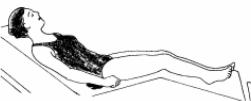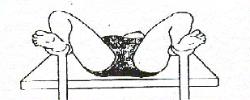
|
Lesson 1: Assisting with the Physical Exam
The history and the physical exam provide much of the information known about the patient's health status. As a practical nurse, you may be called upon to assist the physician or other health care providers during a physical examination. You should know the basics of the examination in order to have the appropriate equipment and supplies on hand, and so that you may place the patient in the proper position and drape him correctly.
1-2. PURPOSES FOR PERFORMING A PHYSICAL EXAMINATION
The physical examination can be performed by the following health care providers: a physician, nurse practitioner, or physician assistant. The health care provider makes specific and general observations as he examines the patient from head to toe. The exam should include the eyes, ears, nose, mouth, throat, neck, chest, breasts, abdomen, and extremities. A vaginal or rectal examination is performed if indicated. The purposes for performing a physical examination are:
a. To determine the patient's level of health or physiological function.
b. To arrive at a tentative diagnosis when there is a health problem or disease.
c. To confirm a diagnosis of disease or dysfunction.
d. To evaluate the effectiveness of prescribed medical treatment and therapy.
1-3. FUNCTIONS OF THE PRACTICAL NURSE DURING THE EXAMINATION PROCEDURE
a. Ensure that the patient feels comfortable and is not embarrassed. Prior to the examination, tell the patient what will take place and explain the reason for the procedure. The patient who knows what to expect will be more relaxed and cooperative.
b. Ask the patient to void into a urine specimen cup in order to empty the bladder and save the urine specimen for urinalysis. Have the patient put on a hospital gown so that his body is more accessible for examination.
c. Arrange equipment and supplies. Be sure that you have everything needed (see Table 1-1). Test all equipment to make certain that it works correctly.
|
Supplies and Equipment |
|
|
Hospital gown Sheet or disposable paper drapes Bath blanket (to prevent chill) Tray with flashlight, gloves, lubricant normal saline, cotton- tipped applicators, and tissues Basin for soiled instruments Waste container for paper goods Scale with height measuring rod Gooseneck lamp or hospital light Gloves Thermometer (oral or rectal)Tape measure Tongue depressorsOphthalmoscope (for examining eyes) |
Otoscope (for examining ears) Tuning fork Blood pressure apparatus and stethoscope Percussion hammer (to check reflexes) Red and blue pencils (to mark skin) Small speculum (for nose examination) Head mirror (to reflect light into body orifice, such as the throat You may also need slides, blood tubes, a vaginal speculum, or other equipment; medications; and a surgical permit if a biopsy or other tests are to be done. |
Table 1-1. Supplies and equipment.
d. Accompany the patient to the examination room and assist him onto the table. Your presence lends support and reassurance to the patient. If a male is examining a female patient, or vice versa, stay in the room to protect the patient, the health care provider, and the hospital or clinic.
e. Wash your hands and measure the patient's vital signs (temperature, pulse, respiration, blood pressure), height, and weight. Wear gloves if the patient has a draining wound, is bleeding, is vomiting, or has an infection. (See Universal Body Substance Precautions in this subcourse).
f. Have the patient's chart available. The physician needs to know the information that has already been obtained via the nursing observations and lab reports. Call the physician's attention to any abnormal lab values. Do this away from the patient.
g. Have all lab slips and x-ray slips ready with the patient's name, rank, social security number, date, and other required information.
h. Assist the patient to assume the proper position for each part of the examination (see figures 1-1 to 1-7). To provide continuing privacy, be sure to adjust the drapes each time the patient assumes a different position. If the patient is asked to stand erect, place paper towels on the floor or have the patient put on slippers.
i. Hand instruments and supplies to the physician. Properly label and care for all specimens collected.
j. See that the patient is returned safely to his room and is comfortable.
k. Place all instruments in the proper area for disinfection or sterilization and dispose of all wastes. Wash your hands again. See that the examination room is cleaned. Decontaminate the room if necessary. Change the cover on the tables. Replace all equipment.
Figure 1-1. Horizontal recumbent position. |
 Figure 1-2. Dorsal recumbent position. |
 Figure 1-3. Fowler's position. |
 Figure 1-4. Dorsal lithotomy position. |
 Figure 1-5. Prone position. |
 Figure 1-6. Simís position. |
 Figure 1-7. Knee-chest position. |
1-4. POSITIONING A PATIENT FOR EXAMINATION OR TREATMENT
Patients are put in special positions for examination, for treatment or test, and to obtain specimens. You should know the positions used, how to assist the patient, and how to adjust the drapes.
a. Horizontal Recumbent Position. Used for most physical examinations. Patient is on his back with legs extended. Arms may be above the head, alongside the body or folded on the chest.
b. Dorsal Recumbent Position. Patient is on his back with knees flexed and soles of feet flat on the bed. Fold sheet once across the chest. Fold a second sheet crosswise over the thighs and legs so that genital area is easily exposed.
c. Fowler's Position. Used to promote drainage or ease breathing. Head rest is adjusted to desired height and bed is raised slightly under patient's knees
d. Dorsal Lithotomy Position. Used for examination of pelvic organs. Similar to dorsal recumbent position, except that the patient's legs are well separated and thighs are acutely flexed. Feet are usually placed in stirrups. Fold sheet or bath blanket crosswise over thighs and legs so that genital area is easily exposed. Keep patient covered as much as possible.
e. Prone Position. Used to examine spine and back. Patient lies on abdomen with head turned to one side for comfort. Arms may be above head or alongside body. Cover with sheet or bath blanket.
NOTE: An unconscious patient, or one with an abdominal incision or breathing difficulty usually cannot lie in this position.
f. Sim's Position. Used for rectal examination. Patient is on left side with right knee flexed against abdomen and left knee slightly flexed. Left arm is behind body; right arm is placed comfortably.
NOTE: Patient with leg injuries or arthritis usually cannot assume this position.
g. Knee-Chest Position. Used for rectal and vaginal examinations and as treatment to bring uterus into normal position. Patient is on knees with chest resting on bed and elbows resting on bed or arms above head. Head is turned to one side. Thighs are straight and lower legs are flat on bed.
NOTE: Do not leave patient alone; he/she may become dizzy, faint, and fall.
